The capital of Khyber-Pukhtunkhwa (NWFP), is a frontier town, the meeting place of the subcontinent and Central Asia. It is perhaps the oldest living city in this part of Asia – a place where ancient traditions jostle with those of today, and where the bazaar in the old city has changed little in the last hundred years except to become the neighbor of a modern university, some modern hotels, some international banks and one of the best museums in Pakistan.No other city is quite like old Peshawar.
The bazaar within its walls is like an American Wild West movie costumed as a Bible epic. Pathan (Pukhtun or Pashtun) tribesmen stroll down the street, their hands hidden inside their shawls and their faces partly covered by the loose ends of their turbans (they have now been forbidden to walk armed in town). With his piercing eyes and finely chiseled nose, the Pathan must be the most handsome man on earth. Overlooking all the crowded and narrow streets are the massive Balahisar Fort — still used by the army, and the elegant Mahabat Khan Mosque. The railway, built by the British, divides Peshawar’s old town from the Cantonment, laid out by the British after 1850, with wide tree-lined streets bordered by once gracious administrative buildings and spacious bungalows in large gardens.
Clubs, churches, schools, The Mall, Saddar Bazaar, and the airport are all part of the British contribution to modern Peshawar. Peshawar University, founded in 1950, and surrounded by University Town, lies to the west on the road to the Khyber Pass. Hayatabad, the newest suburb, is west of the university nearer the Khyber Pass.
Khyber Bazaar
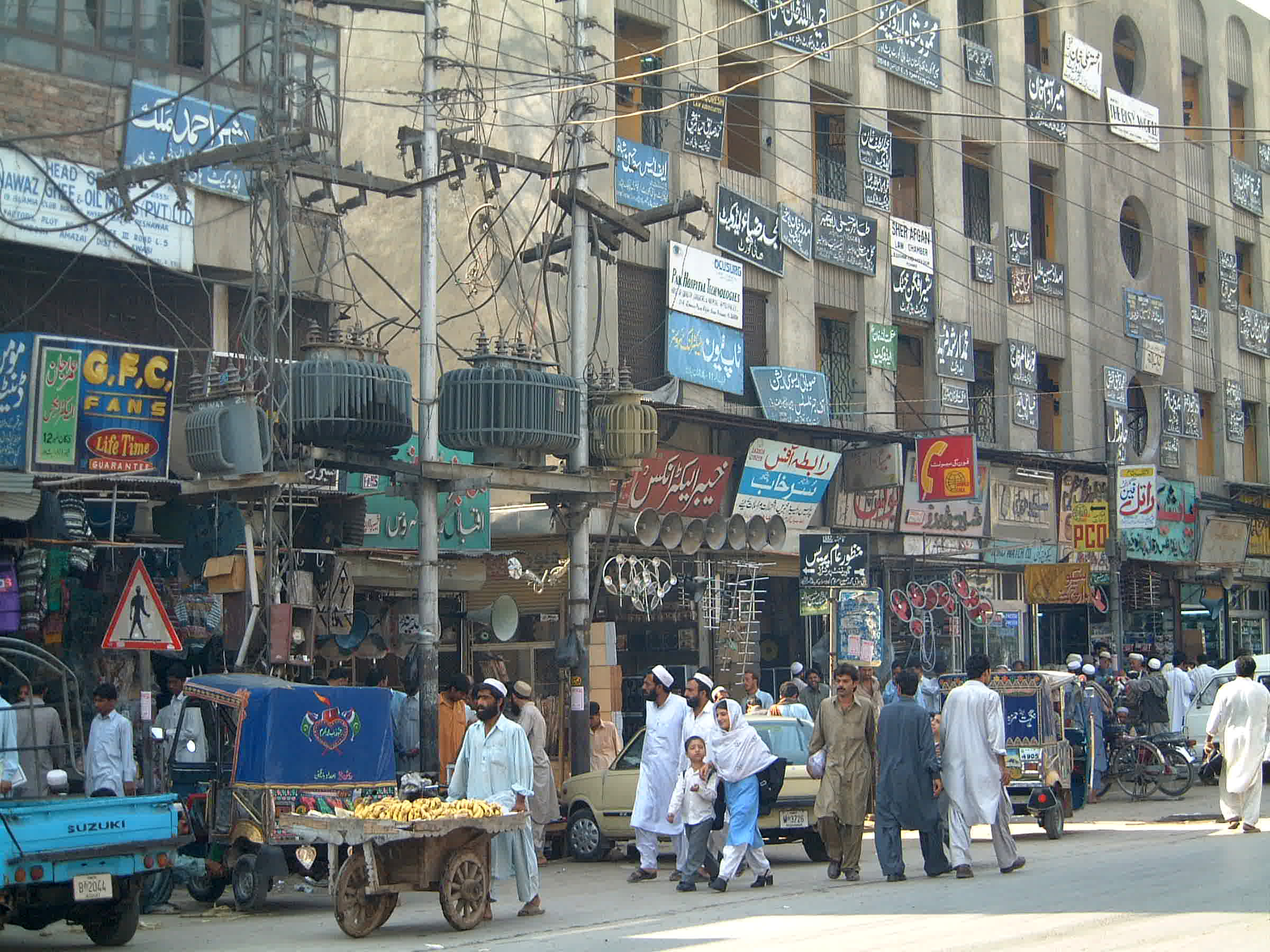
Here you will find many of Peshawar’s cheaper hotels and, in the evening, food stalls selling excellent kebabs and fry-ups. Meat is sold by weight and then cooked while you watch. The main street, full of doctors, lawyers, and dentists, features billboards depicting sets of false teeth of nightmarish proportions. Kabuli Gate, one of the walled city’s 16 gates, is at the end of Khyber Bazaar. The wall survived until the mid-1950s, and though the names remain, the gates and the wall have, for the most part, disappeared.
Qissa Khawani Bazar
Qissa Khawani (Story-tellers’) Bazaar was described in the mid-19th century by the British Commissioner in Peshawar, Sir Herbert Edwardes, as ‘the Piccadilly of Central Asia’. Towering over the street are tall, narrow buildings with intricately carved balconies and window frames. Before the advent of radios and television, the art of professional storytelling flourished in the traditional teahouses and balakhanas in the bazaar. The storyteller relied on his tongue and his imagination to earn his livelihood. The tales were partly narrated, and partly sung to an audience of traders and travelers arriving with their caravans from distant corners of the world.
Chitrali Bazaar

Chitrali Bazaar is in the street to the right (south) and a great place to shop for traditional woolen hats (pakol) and waistcoats. Mochi Lara nearby offers traditional footwear (chapli)
Brass And Copper Shops
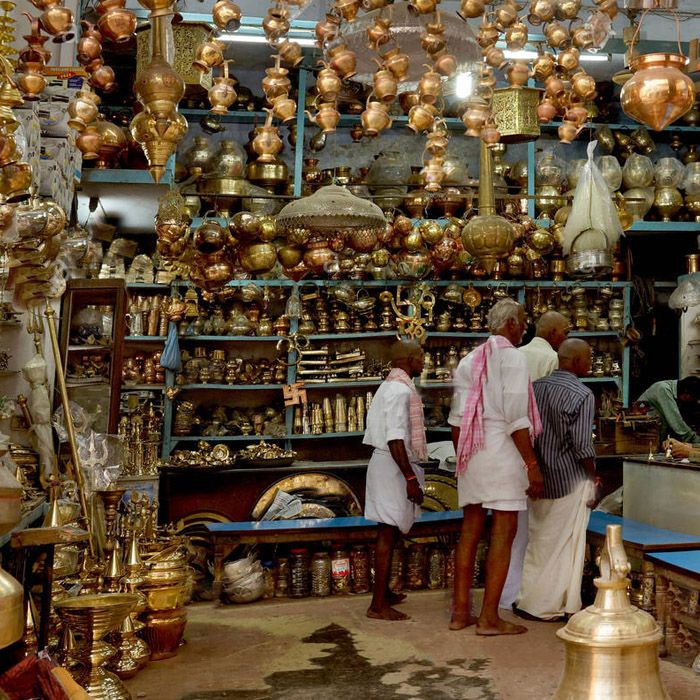
Brass and copper shops are in the street to the left (northwest) at the end of Qissa Khawani. These sell a range of new and old wares. Ali Brothers on the left is the best–known and sells Gardner Russian china plus brass and copper
Peshawar Pottery

The Peshawar Pottery is down a side street on the left, immediately after the brass shops. Here you can watch the potters at work from 10.00 to 16.00, except Fridays. The wide range of ornamental and utilitarian pottery is glazed in strong earthy colors.
Blankets And Shawls
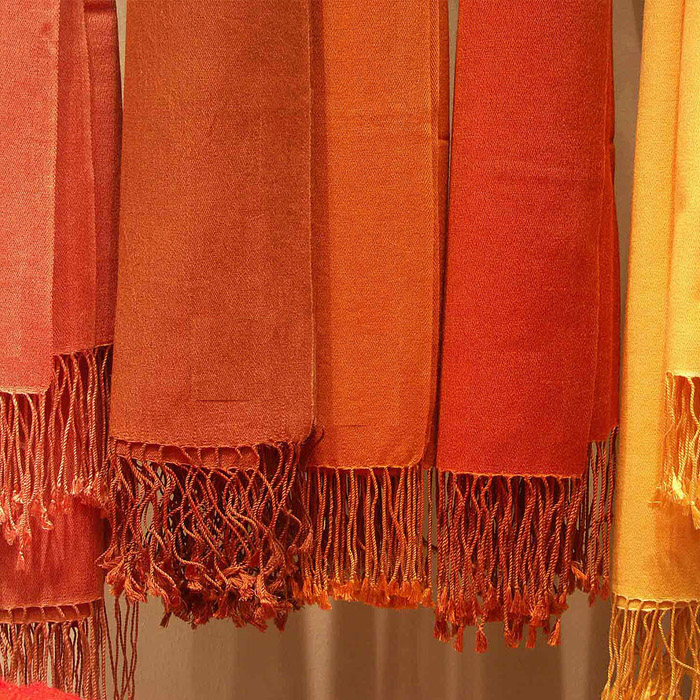
Back on the main street are the shops selling blankets and shawls from the valley of Swat. Made of handspun wool, they are predominantly red and black with brightly patterned borders. The lane to the right (southeast), opposite the street to the pottery, leads to the cloth bazaar. Beyond that is the basket bazaar, where baskets from Dera Ismail Khan are sold. Here also is the Banjara Bazaar, which specializes in unusual decorative items such as bells, bone and wooden beads, and hair braids. Ask here for the way to Peepul Mundi, the main grain wholesale market, where there is a Peepul tree believed to be the offspring of the tree under which the Buddha preached. If you choose instead to continue on the main street towards Chowk Yadgar, you pass the bird market and more cloth shops selling all types of chadors (multi–purpose sheets) and block prints.
Chowk Yadgar

Chowk Yadgar is the ‘Speaker’s Corner’ and the central square of old Peshawar. The monument at the center commemorates the heroes of the 1965 Indo–Pakistan War and is the traditional town meeting place, where most political rallies and demonstrations take place. On the left of the square, the money changers squat on their hand-knotted carpets with their safes behind them and their pocket calculators and mobile phones at the ready. They will change any currency but only accept clean notes.
Andershehr Bazaar
From Chowk Yadgar there are two interesting walks, one to the west and the other to the east. Running off the square to the west is Andershehr Bazaar, a narrow street of gold- and silversmiths selling jewelry (both tribal and modern), antique silver, old coins, and military buttons and buckles. While you rummage through the boxes of treasures, trying on nomads’ earrings, the shopkeeper plies you with cups of sweet green tea brewed in huge copper samovars. Shinwari Plaza, 70 meters beyond the Mahabat Mosque on the right, is a plaza full of the best Afghan shops, a happy hunting ground for jewelry and carpets, and all things Afghan.
Mahabat Khan Mosque
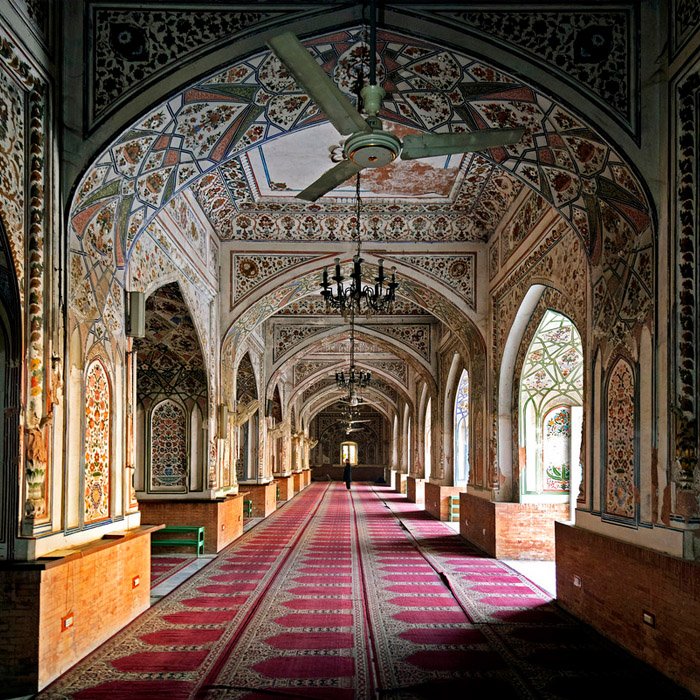
Mahabat Khan Mosque is at the top of the hill on the right (north), its entrance a narrow gateway between the jewellery shops. Built in the 1670s, this beautifully proportioned Mughal mosque, named after a regional governor who served under both emperors Shah Jahan and Aurangzeb, is orthodox in design. Its open courtyard has an ablution pond in the middle and a single row of rooms around the sides. The prayer hall on the west is flanked by two tall minarets. According to the late 19th-century Gazetteer, the minarets were frequently used in Sikh times ‘as a substitute for the gallows’. A fire that raged through the Andershehr Bazaar in 1895, (the Gazeteer continues) failed to destroy the mosque thanks only to the ‘unremitting efforts of the faithful’. The interior of the prayer hall is sheltered beneath three low fluted domes and is lavishly and colourfully painted with floral and geometric designs.From Andershehr Bazaar, a street leads into Dhaki Munawar Shah where the famous Bollywood actor Raj Kapoor’s ancestral house is located. Dilip Kumar’s house is nearby too.
Cunningham Clock Tower
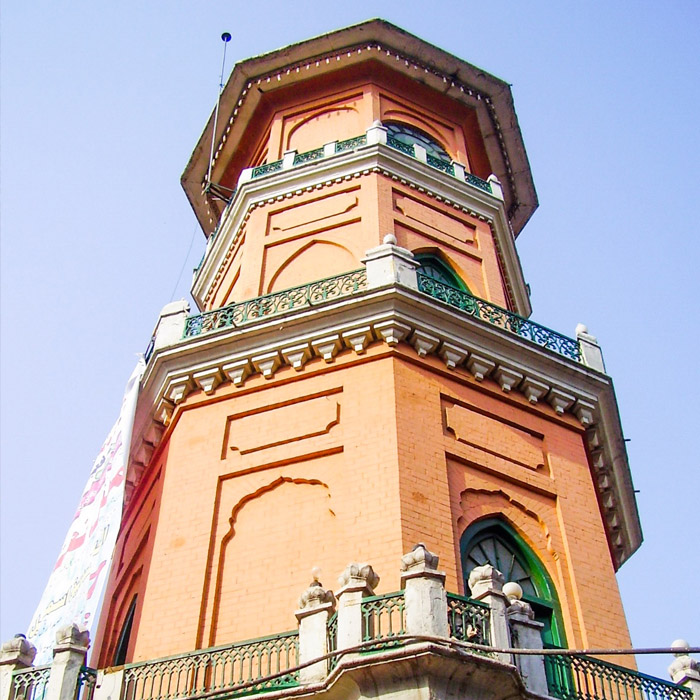
However, if you start again at Chowk Yadgar, but go east this time, you pass the ancient vegetable market on the right and an alley full of hardware shops on the left before coming to the Cunningham Clock Tower. It was built in 1900 ‘in commemoration of the Diamond Jubilee of Her Majesty the Queen Empress’, but is named after commissioner of Peshawar of that period. A marble tablet on one side of the monument calls one’s attention to the sacrifices made by the people of the city in foreign lands: “From this city 200 men went to the Great War 1914-1919 of these 7 gave up their lives.”The leather and skin market around the clock tower features the skins of very young Karakul lambs, and many of the shops have tailors on hand to make astrakhan hats.
Meena Bazaar
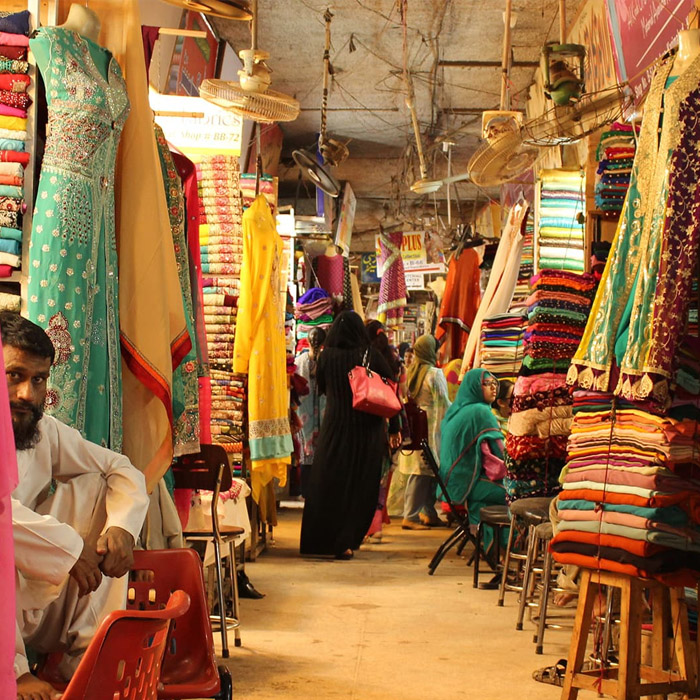
The Meena Bazaar, the Women’s Bazaar, is down the alley to the right (south) from the clock tower. Groups of black-tented women flit like ravens between the stalls shopping for beads, trimmings, machine embroidery and trinkets. Visitors considering adopting purdah can buy their burqa (veil) here in a choice of colours.Further up the hill from the clock tower is the shoe bazaar, which is down an alley on the right. Next is the blockprinting shop where cloth is handprinted using a variety of carved wooden blocks dipped in different coloured dyes.
Sethi Street
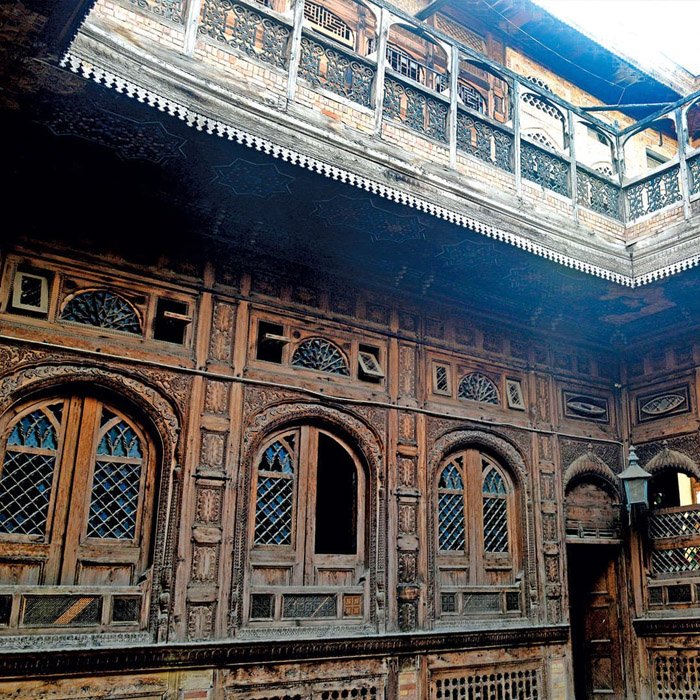
Sethi Street continues up the hill to the Mughal caravanserai (Gor Khatri). Most of the old interconnected houses here belong to the Sethi family, one of the oldest merchant families in Peshawar. They once had offices in Czarist Russia and Shanghai; they imported silks and china and exported cloth, indigo and tea. The tall houses with wooden balconies have intricately carved wooden doors leading into spacious courtyards. Cool cellars, 15 metres deep, provide a retreat from the heat in summer. Victorian glass chandeliers evoke 19th-century opulence. Hidden inside these houses, covering their ceilings and walls like a mantle, is decorative woodwork of exquisite quality. Through a galaxy of pre-Islamic, Moghul, Sikh and even British motifs, much of Peshawar’s rich and varied cultural history can be traced.
Gor Khatri
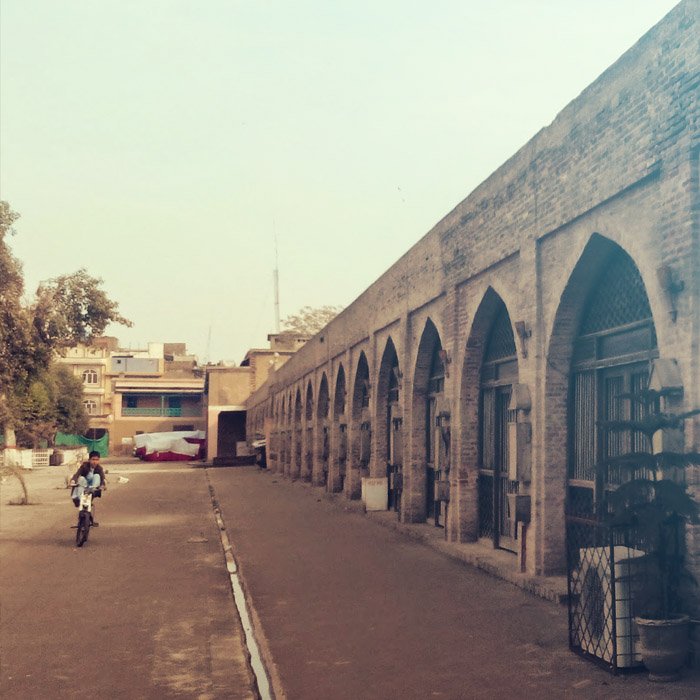
The Gor Khatri was once a Mughal caravanserai crowning the hill at the top end of Sethi Street. Huge Mughal gateways on either end lead into a large courtyard, over 200 metres square, that was once surrounded on all four sides by rooms for travellers. The site has been considered holy for more than 2,000 years. In the second century AD, it was a Buddhist shrine and monastery known as the Tower of the Buddha’s Bowl. Remains of a Sikh temple to Gorakhnath, a yogi sect, stand in the south-eastern corner of the courtyard, with a shrine to Nandi beside it.An ongoing archaeological dig in the north-eastern corner of Gor Khatri has established that Peshawar is one of the earliest living cities in this part of Asia, inhabited continuously from the 4-6th century BC, when it was a province of the Persian Achaemenian Empire. From then onwards it was ruled in turn by the Mauryans, Greeks, Scythians, Kushans, Sasanians, White Huns, Hindu Shahis, Ghaznavids, Ghorids, Suri Afghans, Mughals, Durrani Afghans, Sikhs, and the British, before becoming Pakistan in 1947.
